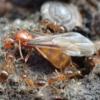They almost always fly on the earliest day of the year that it's "warm" out, roughly above 70F; 75F is better. So first day you can step outside and say "I don't need a coat on."
Flights will happen in the late afternoon if they happen at all. Let me explain: If the ground is moist from passing rains or melting snow then they likely won't start to fly until the very last hour before sundown (after 5ish). Sometimes they do a teas flight, where queens emerge from colonies but don't take off and wonder back inside. These are annoy but they happen.
As ideal days happen though the queens should make it out of the nest sooner and sooner as the day goes on. And this will go on right up until they're out of the nest and flying before noon! The workers are basically kicking them out of the nest at that point.
Males of the species out number queens roughly 200 to 1, maybe even more. They form swarms around trees, bushes, and low standing objects of similar shapes. (not necessarily a car but maybe a power pole.) They don't care about the wind speed either, I've seen flights happen with 60mph gusts. Often they'll be gathered among trees along a forest edge or just inside, perhaps along a path. Usually trees haven't leafed out at this point so things still look pretty dead. Swarms of males will look like thousands and thousands of gnats all dotting and dancing around trees. Queens are slow to arrive, but when they do it's usually 1 every 5 to 15 minutes. Typically I just walk from tree to tree and examine the trunk a bit before moving onto the next one and I repeat this an hour or two. Sometimes I don't find any queens at all, other times I'm finding one every 5 minutes. An issue is they're quick to be pounced upon by several males, and then quickly walk either up the trunk or into the adjacent leaf litter and are quickly lost from sight.
This species while abundant along forest edges, can also be found in suburbia where smaller swarms of males fly around the trunks of single specimen trees. While I have found a couple dozen males dancing around the trees in my yard, I'm not sure it's worth it to stand there waiting for queens to show up. I'm sure queens do show up to these but presumably they're more attracted to the much larger swarms happening in the forests. Also I knew someone, in Colorado I think, who lives on a farm surrounded by forest land, but they have a single tree next to their house. Each year it's completely overrun by P. imparis males and several dozen colonies actually nest under it. There are swarms happening along the forest edge too all around his farm but it seems this one tree picks up enough stragglers that it's created its own population. So a single specimen tree can still work in a very open situation, but maybe not when there are visual obstetrical in the way such as fences, and gardens, and such.
Another tip would be to keep an eye out in all the ant forums as well as the ID Request section in Bug Guide.


















